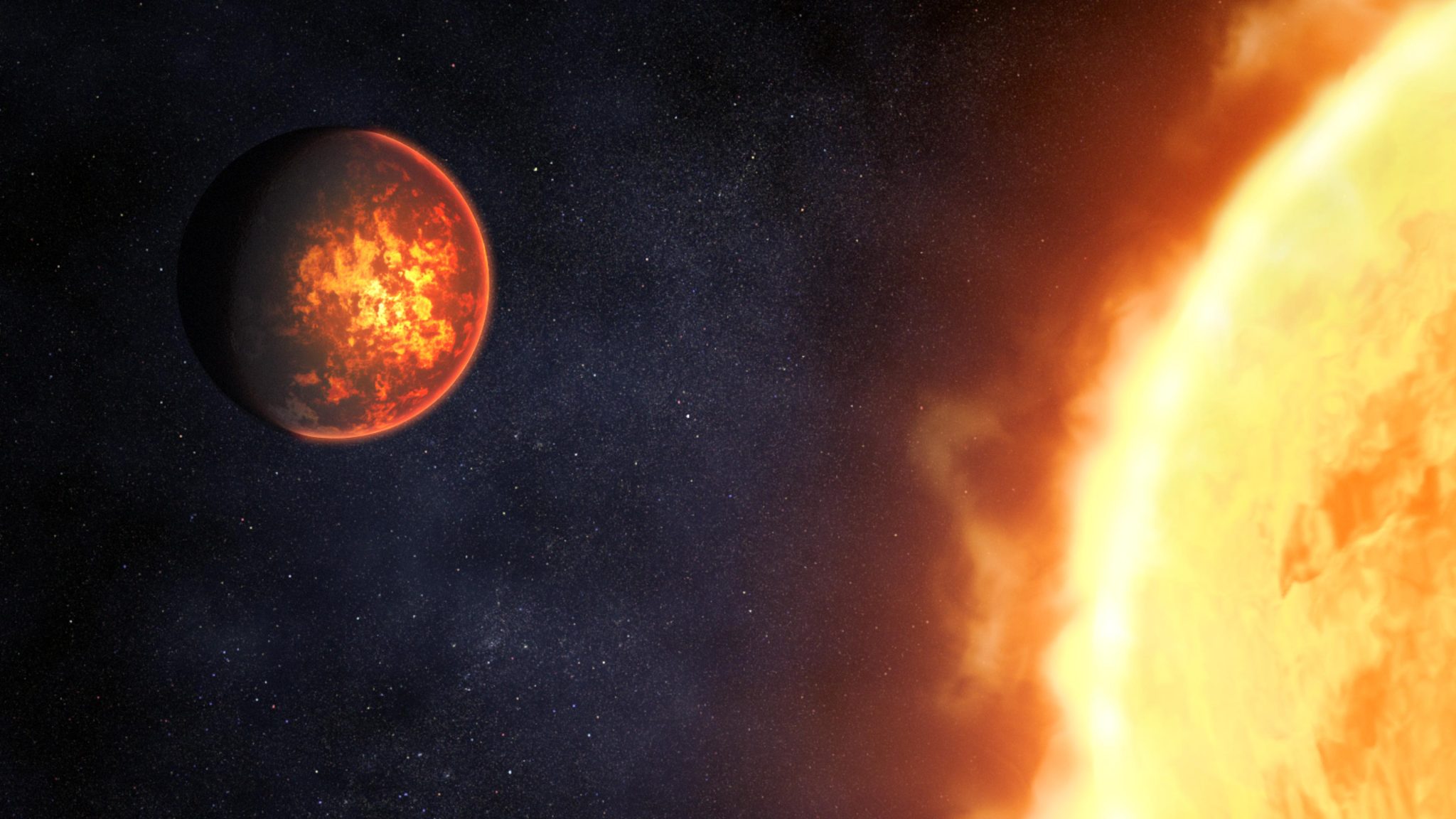
Μια απεικόνιση που δείχνει πώς θα μπορούσε να μοιάζει ο πλανήτης 55 Cancri E, με βάση την τρέχουσα κατανόηση του πλανήτη. 55 Το Cancri είναι ένας βραχώδης πλανήτης περίπου διπλάσια από τη διάμετρο της Γης και σε τροχιά μόλις 0,015 AU από το αστέρι του που μοιάζει με τον ήλιο. Λόγω της στενής τροχιάς του, ο πλανήτης είναι εξαιρετικά ζεστός, με θερμοκρασίες κατά τη διάρκεια της ημέρας που φτάνουν τους 4.400 βαθμούς Φαρενάιτ (περίπου 2.400 βαθμούς Κελσίου). Οι φασματοσκοπικές παρατηρήσεις με τη χρήση της κάμερας εγγύς υπέρυθρης ακτινοβολίας (NIRCam) και του οργάνου μεσαίας υπέρυθρης ακτινοβολίας (MIRI) του Webb θα βοηθήσουν στον προσδιορισμό του εάν ο πλανήτης έχει ή όχι ατμόσφαιρα και, εάν ναι, από τι αποτελείται αυτή η ατμόσφαιρα. Οι παρατηρήσεις θα βοηθήσουν επίσης να καθοριστεί εάν ο πλανήτης σταδιακά κλείνει ή όχι. Πίστωση: NASA, ESA, CSA, Danny Player (STScI)
Οι αστρονόμοι θα εκπαιδεύσουν ένα φασματόμετρο Webb υψηλής ανάλυσης σε δύο ενδιαφέροντες βραχώδεις εξωπλανήτες.
Φανταστείτε αν η Γη ήταν πολύ πιο κοντά στον ήλιο. Τόσο κοντά που ένας ολόκληρος χρόνος θα διαρκούσε μόνο λίγες ώρες. Τόσο κοντά που η βαρύτητα έχει κλειδώσει το ένα ημισφαίριο στο καυτό φως της ημέρας και το άλλο στο αιώνιο σκοτάδι. Τόσο κοντά που οι ωκεανοί βράζουν, οι βράχοι αρχίζουν να λιώνουν και η λάβα πέφτει βροχή στα σύννεφα.
Αν και δεν υπάρχει κάτι τέτοιο στο ηλιακό μας σύστημα, πλανήτες σαν αυτόν—βραχώδεις, με μέγεθος περίπου της Γης, εξαιρετικά θερμοί και κοντά στα αστέρια τους— δεν είναι ασυνήθιστοι στο ηλιακό μας σύστημα.[{” attribute=””>Milky Way galaxy.
What are the surfaces and atmospheres of these planets really like? NASA’s James Webb Space Telescope is about to provide some answers.

Illustration showing what exoplanet LHS 3844 b could look like, based on current understanding of the planet.
LHS 3844 b is a rocky planet with a diameter 1.3 times that of Earth orbiting 0.006 astronomical units from its cool red dwarf star. The planet is hot, with dayside temperatures calculated to be greater than 1,000 degrees Fahrenheit (greater than about 525 degrees Celsius). Observations of the planet’s thermal emission spectrum using Webb’s Mid-Infrared Instrument (MIRI) will provide more evidence to help determine what the surface is made of. Credit: NASA, ESA, CSA, Dani Player (STScI)
Geology from 50 Light-Years: Webb Gets Ready to Study Rocky Worlds
With its mirror segments beautifully aligned and its scientific instruments undergoing calibration, NASA’s James Webb Space Telescope (Webb) is just weeks away from full operation. Soon after the first observations are revealed this summer, Webb’s in-depth science will begin.
Included in the investigations planned for the first year are studies of two hot exoplanets classified as “super-Earths” for their size and rocky composition: the lava-covered 55 Cancri e and the airless LHS 3844 b. Scientists will train Webb’s high-precision spectrographs on these planets with a view to understanding the geologic diversity of planets across the galaxy, as well as the evolution of rocky planets like Earth.
Super-Hot Super-Earth 55 Cancri e
55 Cancri e orbits less than 1.5 million miles from its Sun-like star (one twenty-fifth of the distance between Mercury and the Sun), completing one circuit in less than 18 hours. With surface temperatures far above the melting point of typical rock-forming minerals, the day side of the planet is thought to be covered in oceans of lava.

Illustration comparing rocky exoplanets LHS 3844 b and 55 Cancri e to Earth and Neptune. Both 55 Cancri e and LHS 3844 b are between Earth and Neptune in terms of size and mass, but they are more similar to Earth in terms of composition.
The planets are arranged from left to right in order of increasing radius.
Image of Earth from the Deep Space Climate Observatory: Earth is a warm, rocky planet with a solid surface, water oceans, and a dynamic atmosphere.
Illustration of LHS 3844 b: LHS 3844 b is a hot, rocky exoplanet with a solid, rocky surface. The planet is too hot for oceans to exist and does not appear to have any significant atmosphere.
Illustration of 55 Cancri e: 55 Cancri e is a rocky exoplanet whose dayside temperature is high enough for the surface to be molten. The planet may or may not have an atmosphere.
Image of Neptune from Voyager 2: Neptune is a cold ice giant with a thick, dense atmosphere.
The illustration shows the planets to scale in terms of radius, but not location in space or distance from their stars. While Earth and Neptune orbit the Sun, LHS 3844 b orbits a small, cool red dwarf star about 49 light-years from Earth, and 55 Cancri e orbits a Sun-like star roughly 41 light-years away. Both are extremely close to their stars, completing one orbit in less than a single Earth day.
Credit: NASA, ESA, CSA, Dani Player (STScI)
Planets that orbit this close to their star are assumed to be tidally locked, with one side facing the star at all times. As a result, the hottest spot on the planet should be the one that faces the star most directly, and the amount of heat coming from the day side should not change much over time.
But this doesn’t seem to be the case. Observations of 55 Cancri e from NASA’s Spitzer Space Telescope suggest that the hottest region is offset from the part that faces the star most directly, while the total amount of heat detected from the day side does vary.
Does 55 Cancri e Have a Thick Atmosphere?
One explanation for these observations is that the planet has a dynamic atmosphere that moves heat around. “55 Cancri e could have a thick atmosphere dominated by oxygen or nitrogen,” explained Renyu Hu of NASA’s Jet Propulsion Laboratory in Southern California, who leads a team that will use Webb’s Near-Infrared Camera (NIRCam) and Mid-Infrared Instrument (MIRI) to capture the thermal emission spectrum of the day side of the planet. “If it has an atmosphere, [Webb] Έχει την ευαισθησία και το εύρος μήκους κύματος για να ανιχνεύσει και να αναγνωρίσει τα συστατικά του.»
Ή μήπως βρέχει λάβα το βράδυ στο 55 Cancri E;
Ωστόσο, μια άλλη ενδιαφέρουσα πιθανότητα είναι ότι το 55 Cancri e δεν είναι κλειδωμένο με στεφάνη. Εναλλακτικά, μπορεί να είναι σαν τον Ερμή, που περιστρέφεται τρεις φορές ανά δύο τροχιές (αυτό που είναι γνωστό ως συντονισμός 3:2). Ως αποτέλεσμα, ο πλανήτης θα έχει κύκλο ημέρας και νύχτας.
«Αυτό μπορεί να εξηγήσει γιατί το θερμότερο μέρος του πλανήτη γυρίζει», εξήγησε ο Alexis Brandecker, ερευνητής από το Πανεπιστήμιο της Στοκχόλμης που ηγείται μιας άλλης ομάδας που μελετά τον πλανήτη. “Ακριβώς όπως στη Γη, θα χρειαστεί χρόνος για να θερμανθεί η επιφάνεια. Η πιο ζεστή ώρα της ημέρας θα είναι το απόγευμα, όχι το μεσημέρι.”

Το φάσμα εκπομπής δυναμικού θερμότητας του θερμού εξωπλανήτη σούπερ-Γης LHS 3844 b, όπως μετρήθηκε από το Mid-Infrared Instrument του Webb. Το φάσμα θερμικής εκπομπής δείχνει την ποσότητα φωτός διαφορετικών μηκών κύματος υπέρυθρων (χρώματα) που εκπέμπεται από τον πλανήτη. Οι ερευνητές χρησιμοποιούν μοντέλα υπολογιστών για να προβλέψουν πώς θα μοιάζει το φάσμα εκπομπής θερμότητας ενός πλανήτη, υποθέτοντας ορισμένες συνθήκες, όπως αν υπάρχει ή όχι ατμόσφαιρα και από τι αποτελείται η επιφάνεια του πλανήτη.
Αυτή η συγκεκριμένη προσομοίωση υποθέτει ότι το LHS 3844 b δεν έχει ατμόσφαιρα και ότι η πλευρά της ημέρας καλύπτεται από σκοτεινά πυριγενή πετρώματα. (Ο βασάλτης είναι το πιο κοινό πυριγενές πέτρωμα στο ηλιακό μας σύστημα, που αποτελεί ηφαιστειακά νησιά όπως η Χαβάη και το μεγαλύτερο μέρος του ωκεανού βυθού της Γης, καθώς και μεγάλα τμήματα των επιφανειών της Σελήνης και του Άρη.)
Για σύγκριση, η γκρίζα γραμμή αντιπροσωπεύει ένα τυπικό φάσμα βασαλτικών πετρωμάτων με βάση εργαστηριακές μετρήσεις. Η ροζ γραμμή είναι το φάσμα του γρανίτη, που είναι το πιο κοινό πυριγενές πέτρωμα που βρίσκεται στις ηπείρους της Γης. Τα δύο πετρώματα έχουν πολύ διαφορετικά φάσματα επειδή αποτελούνται από διαφορετικά ορυκτά που απορροφούν και εκπέμπουν διαφορετικές ποσότητες διαφορετικών μηκών κύματος φωτός.
Αφού ο Webb εντοπίσει τον πλανήτη, οι ερευνητές θα συγκρίνουν τα πραγματικά μοντέλα φασμάτων διαφορετικών τύπων πετρωμάτων όπως αυτό για να δουν από τι αποτελείται η επιφάνεια του πλανήτη.
Πηγή: NASA, ESA, CSA, Dani Player (STScI), Laura Kreidberg (MPI-A), Renyu Hu (NASA-JPL)
Η ομάδα του Brandeker σχεδιάζει να δοκιμάσει αυτήν την υπόθεση χρησιμοποιώντας το NIRCam για να μετρήσει τη θερμότητα που εκπέμπεται από τη φωτισμένη πλευρά του 55 Cancri e μέσω τεσσάρων διαφορετικών τροχιών. Εάν ένας πλανήτης είχε συντονισμό 3:2, θα παρατηρούσε κάθε ημισφαίριο δύο φορές και θα μπορούσε να ανιχνεύσει οποιαδήποτε διαφορά μεταξύ των δύο ημισφαιρίων.
Σε αυτό το σενάριο, η επιφάνεια θα θερμαινόταν, θα έλιωνε, ακόμη και θα εξατμιζόταν κατά τη διάρκεια της ημέρας, σχηματίζοντας μια εξαιρετικά λεπτή ατμόσφαιρα που θα μπορούσε να ανιχνεύσει ο Webb. Το βράδυ, ο ατμός ψύχεται και συμπυκνώνεται για να σχηματίσει σταγόνες λάβας που θα βρέξουν ξανά στην επιφάνεια, μετατρέποντας ξανά σε στερεή κατάσταση μέχρι το βράδυ.
Κάπως πιο δροσερό Super Earth LHS 3844 b
Ενώ το 55 Cancri e θα παρέχει πληροφορίες για την παράξενη γεωλογία ενός κόσμου καλυμμένου με λάβα, LHS 3844 B Παρέχει μια μοναδική ευκαιρία ανάλυσης σκληρών πετρωμάτων[{” attribute=””>exoplanet surface.
Like 55 Cancri e, LHS 3844 b orbits extremely close to its star, completing one revolution in 11 hours. However, because its star is relatively small and cool, the planet is not hot enough for the surface to be molten. Additionally, Spitzer observations indicate that the planet is very unlikely to have a substantial atmosphere.
What Is the Surface of LHS 3844 b Made of?
While we won’t be able to image the surface of LHS 3844 b directly with Webb, the lack of an obscuring atmosphere makes it possible to study the surface with spectroscopy.
“It turns out that different types of rock have different spectra,” explained Laura Kreidberg at the Max Planck Institute for Astronomy. “You can see with your eyes that granite is lighter in color than basalt. There are similar differences in the infrared light that rocks give off.”
Kreidberg’s team will use MIRI to capture the thermal emission spectrum of the day side of LHS 3844 b, and then compare it to spectra of known rocks, like basalt and granite, to determine its composition. If the planet is volcanically active, the spectrum could also reveal the presence of trace amounts of volcanic gases.
The importance of these observations goes far beyond just two of the more than 5,000 confirmed exoplanets in the galaxy. “They will give us fantastic new perspectives on Earth-like planets in general, helping us learn what the early Earth might have been like when it was hot like these planets are today,” said Kreidberg.
These observations of 55 Cancri e and LHS 3844 b will be conducted as part of Webb’s Cycle 1 General Observers program. General Observers programs were competitively selected using a dual-anonymous review system, the same system used to allocate time on Hubble.
The James Webb Space Telescope is the world’s premier space science observatory. Webb will solve mysteries in our solar system, look beyond to distant worlds around other stars, and probe the mysterious structures and origins of our universe and our place in it. Webb is an international program led by NASA with its partners, ESA (European Space Agency) and the Canadian Space Agency.

“Ερασιτέχνης διοργανωτής. Εξαιρετικά ταπεινός web maven. Ειδικός κοινωνικών μέσων Wannabe. Δημιουργός. Thinker.”



